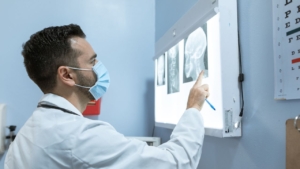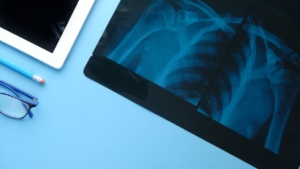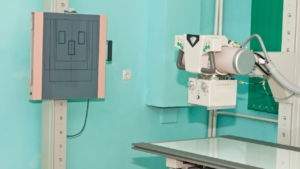Key Takeaways:
- Patient Safety: Prioritizing patient safety is crucial, requiring adherence to strict protocols and minimizing the risk of adverse reactions.
- Best Practices: Thorough patient screening, pre-procedure hydration, appropriate dosing, and real-time monitoring are essential for safe contrast media administration.
- Risk Factors: Identifying and managing risk factors, such as allergies, kidney function, and medication interactions, is critical for patient safety.
- Adverse Reaction Management: Recognizing and effectively managing mild, moderate, and severe reactions is crucial for patient well-being.
- Continuous Improvement: Ongoing training, technological advancements, and adherence to best practices are essential for maintaining a safe and effective contrast media administration process.
Administering IV iodinated contrast media is a cornerstone of modern diagnostic imaging, enhancing the clarity and accuracy of scans.
However, prioritizing patient safety in contrast media administration is critical to minimizing risks and ensuring optimal outcomes.
This guide outlines IV iodinated contrast best practices, including effective contrast media administration guidelines, to support safe and efficient imaging procedures.
The Importance of Patient Safety in Contrast Media Administration
Iodinated contrast in medical imaging plays a crucial role in improving the visualization of internal structures. However, its use comes with potential risks, making iodinated contrast safety protocols essential in every radiology practice.
Why patient safety matters:
- Prevents complications from adverse reactions to contrast media.
- Ensures that imaging results are both reliable and accurate.
- Builds trust between patients and healthcare providers.
Patient safety is a core principle in delivering quality care in radiology.
Best Practices for Administering IV Iodinated Contrast
To promote safe use of iodinated contrast media, healthcare providers must adhere to standardized protocols and practices.
Key best practices include:
- Thorough patient screening:
- Evaluate for allergies, renal function, and other risk factors.
- Identify prior adverse reactions to contrast media.
- Pre-procedure hydration:
- Encourage adequate fluid intake to reduce kidney-related risks.
- Consider intravenous hydration for at-risk patients.
- Use of appropriate dosing protocols:
- Tailor the contrast dose based on patient weight and medical history.
- Follow established contrast media administration guidelines for optimal results.
- Real-time monitoring:
- Observe patients during and after administration for any adverse reactions.
- Be prepared with emergency protocols for managing reactions.
By following these steps, healthcare providers can ensure safe and effective imaging experiences.
Common Risk Factors and Prevention Strategies
Preventing adverse reactions to contrast media requires understanding and addressing patient-specific risk factors.
Risk factors include:
- History of allergies or hypersensitivity to iodinated contrast agents.
- Pre-existing kidney disease or reduced renal function.
- Concurrent use of medications that affect kidney function.
- Dehydration or inadequate fluid levels.
Prevention strategies:
- Use low-osmolar or iso-osmolar contrast media for high-risk patients.
- Administer prophylactic medications, such as antihistamines or corticosteroids, when needed.
- Limit repeated contrast exposure within short timeframes.
Proactively managing risks ensures that patients remain safe throughout the imaging process.
Recognize and Manage Adverse Reactions to Iodinated Contrast Media
Understanding how to identify and respond to adverse reactions to contrast media is a vital component of patient safety. While most reactions are mild, some can escalate quickly if not managed properly.
Types of adverse reactions include:
- Mild reactions: Nausea, vomiting, or mild itching, which typically resolve without intervention.
- Moderate reactions: Symptoms like hives, wheezing, or facial swelling that require medical treatment.
- Severe reactions: Life-threatening anaphylactic responses requiring immediate emergency care.
Prompt identification and effective management of these reactions are critical for ensuring patient safety during imaging procedures.
Importance of Pre-Procedure Communication
Clear communication with patients before administering iodinated contrast in medical imaging is essential for building trust and ensuring cooperation.
Pre-procedure communication should include:
- Educating patients about the purpose of contrast media and the imaging procedure.
- Explaining potential risks and symptoms of adverse reactions to monitor for.
- Providing guidance on pre-procedure preparations, such as hydration and fasting.
This communication fosters a collaborative approach to patient care, enhancing safety and comfort.
Advanced Technologies in Contrast Administration
Technological advancements are transforming how IV iodinated contrast media is administered, improving precision and safety.
Innovative technologies include:
- Automated contrast injectors: Ensuring accurate and consistent dosing.
- Real-time monitoring systems: Detecting early signs of adverse reactions during the procedure.
- AI-driven imaging protocols: Optimizing contrast use based on patient-specific factors.
These technologies enhance the safe and efficient use of contrast media, benefiting both patients and healthcare providers.
The Role of Radiology Best Practices in Patient Care
Patient care in radiology is closely tied to the implementation of IV iodinated contrast best practices. Adhering to these practices not only minimizes risks but also enhances the quality of diagnostic imaging.
Core components of radiology best practices include:
- Comprehensive staff training on iodinated contrast safety protocols.
- Routine equipment checks to ensure proper functioning during contrast media administration.
- Continuous updates to protocols based on the latest research and guidelines.
By prioritizing patient care, radiology departments can deliver safe and reliable imaging services.
Manage Risk in IV Contrast Administration
Managing risk in IV contrast administration involves a combination of preparation, monitoring, and post-procedure care.
Effective risk management strategies include:
- Establishing a dedicated response team to handle emergencies related to contrast reactions.
- Using alternative imaging methods, such as ultrasound or MRI, for patients at high risk.
- Documenting all contrast reactions in patient records to inform future care decisions.
With these measures, healthcare teams can confidently handle complex cases while maintaining safety.
Incorporate Safety Training for Radiology Staff
Radiology teams play a pivotal role in maintaining patient safety in contrast media administration. Ongoing training equips staff with the skills and knowledge needed to adhere to iodinated contrast safety protocols.
Key training areas include:
- Recognizing and managing adverse reactions swiftly and effectively.
- Mastering proper techniques for administering IV iodinated contrast media.
- Staying updated on the latest radiology best practices for contrast media.
Continuous education ensures that radiology departments remain prepared to provide safe and accurate imaging.
Ensure the Safe Use of Iodinated Contrast Media in Special Populations
Certain patient groups require extra precautions to ensure the safe use of iodinated contrast media.
Special populations include:
- Pediatric patients: Adjust doses based on age and weight while closely monitoring for reactions.
- Elderly patients: Account for age-related kidney function decline.
- Pregnant patients: Avoid contrast use unless absolutely necessary and supported by clear clinical indications.
Tailored protocols for these populations safeguard their health while achieving diagnostic goals.
Prioritize Patient Care in Imaging with Advanced Contrast Media
Ensure optimal outcomes with proven IV iodinated contrast best practices and comprehensive contrast media administration guidelines.
Enhance patient safety in contrast media administration with tools and protocols designed to deliver precision and care.
Call Spectrum Medical Imaging Co. today at 800-859-6162 to explore our innovative solutions for safer, more effective diagnostic imaging!




